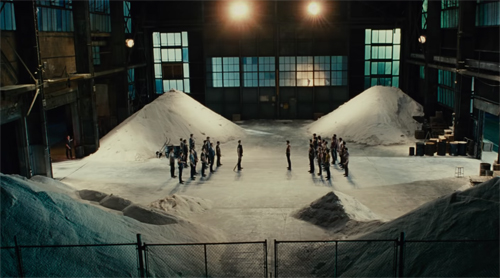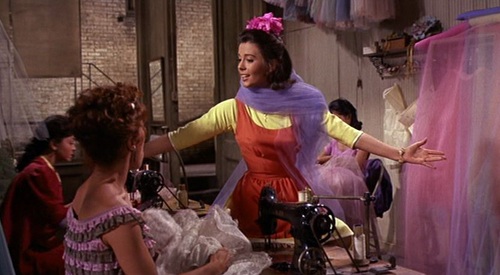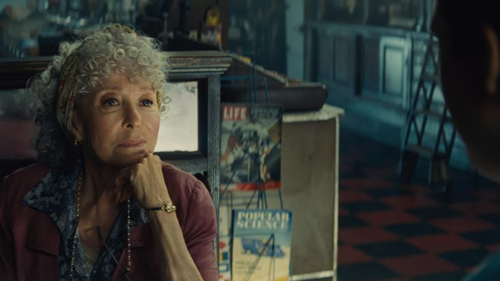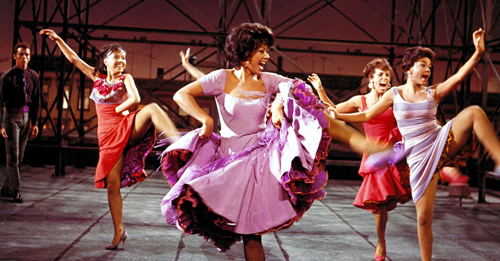
There are few movie musicals that have managed to cross over from the stage to the screen without losing any of it’s artistry. The two mediums couldn’t be more different. For a stage musical, everything is laid out in front of you at once, and your eye is allowed to wander and catch all the details of character and staging put there under the curtain. For a movie, your eye is always directed to what the film wants you to see. On stage, everything is artificial and the art directors and actors work with the power of suggestion to create a sense of a greater world than what our eyes see before us. In a movie, the world is real and tactile. The musical genre can and has thrived in both mediums of entertainment, but rarely do you see a crossover hit. Some stage musicals have been turned into terrible movies, and some movie musicals have turned into terrible stage productions. There are however a few musicals that have managed to crossover and in some cases, be considered among the greatest musicals of all time, both on stage and screen. One such musical that definitely fits this bill is the classic West Side Story. First staged on Broadway in 1957, the musical West Side Story took the age old story of Romeo and Juliet and re-contextualized it into a gang war on the streets of contemporary New York City’s West Side. The book was written by playwright Arthur Laurents and the music was written by concert virtuoso Leonard Bernstein, with lyrics to the songs written by a very young Stephen Sondheim (making his Broadway debut). Though that line-up of talent was impressive enough, the chief creative force behind the stage musical was director and choreographer Jerome Robbins, whose unique style of dance became the defining element of the musical. West Side Story’s Broadway debut was a watershed moment for the theatrical industry and it instantly became a highly influential show in the years that followed. And naturally such a huge success on the Broadway stage is bound to get the attention of Hollywood.
A mere couple of years after it’s stage debut, West Side Story was picked up by United Artists for a screen adaptation. As part of the deal to make the picture, Jerome Robbins was tasked with continuing on as Director, just so they could maintain the same artistic quality that was his distinctive style. However, Robbins was inexperienced in the field of film direction, so United Artists decided to add a co-director to the film to take charge of the cinematic side of the production. That man was Robert Wise, who only a couple years later would go on to solo direct another beloved musical for the silver screen; 1965’s The Sound of Music. With Wise keeping everything looking good on camera and Robbins working tirelessly with the performers to master their complex dance moves, the production of West Side Story went well on it’s way. The cast was made up of a lot of talent straight from the Broadway stage, but there were also some well known faces from Hollywood in there as well; for better and worse. Rising star Richard Beymer was given the key role of Tony (the musical’s Romeo stand-in) and Russ Tamblyn, who had previously shown off his dancing skills in Seven Brides for Seven Brothers (1954) was cast as Riff, leader of the Jets gang. Rita Moreno had been playing bit parts in Hollywood for the better part of a decade (often in demeaning ethnic roles) but now was being given a chance to play an authentic Puerto Rican role for the first time as Anita. And then there was the choice of Natalie Wood in the Role of Maria (the Juliet of this story); a pick that was even controversial in it’s own time. Despite that, West Side Story became a smash hit at the box office and went on to win a staggering 10 Academy Awards, second at the time only to Ben-Hur (1959) which had 11. Over time, the musical has been a high water mark for movie musicals and was often seen as untouchable for several decades afterwards. Who would even dare to attempt to make another version of West Side Story for the big screen?

“When you’re a Jet, you’re a Jet all the way. From your first cigarette to your last dyin’ day.”
Steven Spielberg, that’s who. Spielberg of course is a film director in a class all his own. With a career now in it’s seventh decade, Spielberg had seemed to be a filmmaker with no more mountains left to climb. But, in all that time, he had never once directed a musical. There were musical moments in a number of his movies (the opening of Indiana Jones and the Temple of Doom comes to mind), but a full blown musical film was something that had always eluded him for years. I’m sure for Spielberg, the choice for his first musical had to be a special one; one where his unique cinematic tastes would feel right at home. So, it’s a little surprising that even though there have been plenty of un-adapted stage productions that he could have chosen from, as well as ideas for original movie musicals, he instead chose to take on a musical which had already conquered the screen before. Not only that, but West Side Story is still to this day held up as one of not just the greatest musical movies of all time, but one of the greatest films period. A few believed that even someone like Spielberg couldn’t make it happen; myself included (I mistakenly put it on my Movies to Skip list last year). But, credit the master for finding a way to not only rise up to the challenge, but in some ways even surpassing the original. Spielberg’s adaptation of West Side Story is a remarkably self assured movie musical for someone who has never worked in the genre before, and it makes you wonder why it took Stephen this long to actually getting around to it. Despite being hampered by lower pandemic era box office (including a year long delay from it’s original premiere) 2021’s West Side Story has been a hit in the critical community, and like it’s predecessor, it has been an awards season favorite. It may not match the original’s Best Picture win, but it’s still likely to come away with some gold. What is interesting to note is that despite being from the same source material, the new West Side Story doesn’t feel at all like a remake, but rather like a revival; a new spin on a familiar story better contextualized for our modern day. Comparing the two versions, it’s interesting to see how the same elements have been used differently to help make each film it’s own unique thing.

“Tonight, tonight, It all began tonight, I saw you and the world went away.”
One of the most striking differences between the movies is the use of it’s setting. For the original, the 1961 version opened with a striking flyover of the island of Manhattan, and it’s concrete jungle of streets and skyscrapers. It then brings us down to street level, where we see the rival gangs of the White Jets and the Puerto Rican Sharks, introduced with rhythmic finger snapping to Bernstein’s score. The incredible element of this opening is that it’s all on location in the real New York. There’s nothing that feels more cinematic than watching dancers perform ballet like moves on the same streets and sidewalks that are no doubt littered with traffic on an average day. However, after that opening scene, the rest of the movie goes indoors, with the remaining scenes shot on soundstages; feeling very akin to the artificial look of how it would appear on stage. Though the movie does lose that authenticity of the real world, it still does capture a sense of place through the rest of the film that gives the movie character. The jungle like rows of clotheslines and fire escapes for instance take on this iconic look for the film. Spielberg’s film on the other hand spends a bit more time outdoors, though not in any real place. Spielberg’s West Side Story is a period piece, set in the same time as the original, but with a landscape of a New York City that no longer exists. What is an especially welcome addition to this story is the backdrop of a real life transformation that occurred in the real West Side. During the 1950’s and 60’s, the old West Side was being demolished building by building to make way for new luxury high rises and ironically, the Lincoln Center for the Performing Arts. Both Spielberg and screenwriter Tony Kushner added this element to the story to give a tragic context to underline an extra dilemma in the lives of these characters, as they are watching their neighborhood literally disappear. Spielberg’s production team did a phenomenal job recreating this moment in history, with the West Side appearing like a bombed out city in a surreal and sad way. Both films accomplish the best that they can in visualizing the musical for the screen, and in many ways are pretty equal in terms of visual splendor.
What’s also interesting in the production of both musicals is the way that they use the well known songs in different ways. All the songs from the stage musical are in both films, but their placements are a bit different, and they offer different contexts to what’s being sung in those moments. What I find interesting is the choice of song used after the pivotal Rumble scene. The rumble, of course is the crucial moment where Riff is killed by the Sharks’ leader Bernardo (George Chakiris in 1961, David Alverez in 2021), the brother of Maria. Bernardo is then killed by Tony in revenge, leaving two main characters tragically killed in that moment. In the 1961 version, the song “Cool” is used to follow that scene, with the Jets trying to find a way to cope with the tragedy they just witnessed. This song especially features some of the most distinctly Robbins-esque choreography of the whole movie and is a tour de force of staging for the screen. In Spielberg’s version, the song “Cool” is performed before the Rumble by Tony (Ansel Elgort) as a warning to Riff (Michael Faist). The song is much less powerful in that context, as it just serves to give Tony one more song in Spielberg’s version, and the dancing is not as impressive. But, Spielberg makes a very interesting choice in moving Maria’s song “I Fell Pretty” into a post Rumble placement. It adds a new tragic connotation to that song that isn’t in the 1961 version. In that trade off, Spielberg actually improves on the number, by giving it more weight than it had before. There is one musical number that thankfully shines in both versions; that being the iconic show-stopping number “America.” But even there, both movies have their own unique spins on the song that make it work for their own movies. In the original, Anita, Bernardo, and the remaining Jets all perform the song on a rooftop under a starry night sky. In Spielberg’s version, it’s performed on the streets in bright, sunny daylight. The original also hold the camera still for long takes that lets the viewer take in Jerome Robbins’ incredible choreography, while the newer one almost lets the camera dance along with the characters with some incredible flowing cinematography from DP Janusz Kaminski. These are some interesting creative choices that both work in each movie’s favor, though some in more interesting ways than others.

“See the pretty girl in that mirror there? Who can that attractive girl be? Such a pretty face, such a pretty dress, such a pretty smile. Such a pretty me!”
There is no doubt that the most crucial difference between the movies, and the one that definitely works in Spielberg’s favor is the casting. West Side Story is a story about a clash of cultures, but up until now, we haven’t seen that idea actually depicted correctly on screen. A sad commentary on the time it was made, but most of the Puerto Rican characters in the original West Side Story were played by White actors in brown face. Even Rita Moreno, the only authentic Puerto Rican actor in the cast, was made to darken her fair skin for the role. This has been a contentious point in retrospect for the film, and it sadly makes this well-meaning production about racial tolerance feel hypocritical by today’s eyes. Despite this, the performances in the original are still strong. Both Moreno and Greek-American George Chakiris won Oscars for their roles as Anita and Bernardo. And despite being entirely wrong for the role to begin with, Natalie Wood still tries her best as Maria. Thankfully when it came to casting the new version, Spielberg went out of his way to make sure that the Latino representation was accurate for his cast. The biggest improvement of course was in finding a true Latina actress to play Maria, which they did with Columbian-American Rachel Zegler. She has that same wide-eyed innocence found in Wood’s version, but without the cringe brown face make-up, and she is not dubbed this time like Natalie Wood was. The rest of the cast also is made up of Broadway regulars, and the incredible Rita Moreno returns to play a different role at the age of 90; an incredible 60 years after her first run with the musical. The new version does have a weak spot, however, and it’s sadly Ansel Elgort as Tony. Off screen scandals aside, he’s not exactly giving a terrible performance in this movie. It just becomes clear as you watch the film that he’s a movie actor in a cast full of Broadway stars. he doesn’t ruin the movie as a whole, but you can also feel him dragging the film away from all-time status. Still, the fact that Spielberg went out of his way to right a few cinematic wrongs when it came to representation in his movie, as well as doing some consulting with key members of the Puerto Rican and general Latino communities, is a commendable act, and something that this musical really need for the big screen.
If I were to say that there’s is something that the original still has over the newer version, it’s the level of choreography presented. The dancing in Spielberg’s West Side Story is not bad by any means, and they are especially highlighted with Spielberg’s legendary oners that he always works into his movies. But, they also feel like the standard balletic moves that you see performed in any standard stage musical. The original West Side Story first and foremost reminds you that it’s a Jerome Robbins’ musical. His style of choreography has it’s own unique character, and it’s on full display in the original. Sure, he put his dancers through hell during the making of this movie, with some of them dancing until their heels were bleeding through their shoes. But, all of that hard work is presented there on screen, and the dance numbers in the original are still unmatched all these years later. I think that’s what helps to keep the movie with the lofty reputation that it still enjoys today. It’s a musical with character that could only be achieved through the vision of it’s original creator. Robbins brought this musical to life on the stage, so it’s only fitting that he managed to faithfully carry it over onto the silver screen. With Robert Wise helping to give it that cinematic grandeur, allowing not an inch of that incredible 70mm frame to go to waste, 1961’s West Side Story is a musical all unto it’s own. Just the way that the dancers contort their bodies in that stylized way is something that only Jerome Robbins could’ve imagined. I credit Spielberg for not trying to even attempt to match that level of choreography, instead focusing on the interesting ways to shoot his dance scene; very much acting in a more Robert Wise sense. Both versions are certainly stellar representation of staging incredible dance scenes for a musical; only one is clearly more standard while the other is a bit more Avant Garde.

“There’s a place for us, a time a place for us. Hold my hand and we’re halfway there. Hold my hand and I’ll take you there, somehow, some day, somewhere!”
You’ve definitely got to hand it to Spielberg. He did the nearly unthinkable by trying to follow in the footsteps of a masterpiece and in turn created one of his own. I especially respect how Spielberg managed to find his own voice in this iconic musical, and not try in any way to upstage the original. It’s an adaptation that’s respectful of the original, but at the same time, asserts it’s own own perspective. It’s especially superior in getting across the original message of the story, as Spielberg managed to have an actual culturally diverse cast on board. The original still, however, I think stands just a little higher. It might be just because it’s so familiar to us, being an iconic and influential film for so many years. It’s also because there’s just so much character found in that original. The Jerome Robbins’ choreography is often imitated, but never matched and West Side Story is no doubt his masterwork. But, I would definitely say that from a cinematography standpoint, Spielberg’s film is far more dynamic an experience. The way he soars a camera around a scene, like the incredible Dance in the Gymnasium, is just breathtaking. Once again, it’s unbelievable that this is Spielberg’s first foray into movie musicals. It’s like he’s been preparing for this opportunity his whole life. He never once tries to copy a shot from the original, creating a version of West Side Story that’s all in his own voice, and that helps to make it escape the definition of a remake. It’s Spielberg’s West Side Story while the original is Jerome Robbins’ West Side Story; two great artists giving us two unique perspectives on the same story. It will be interesting to see how well Spielberg’s version holds up over the years. Will it have the same kind of legacy as the original. Too early to know, but one thing is for sure, and that’s the fact that Spielberg proved himself as a musical director. Regardless of which version you chose, you will be treated to a musical for the ages. And it’s remarkable that this one musical has managed to make it’s mark with not one, but two distinctive classics in it’s honored history.

“I like the island Manhattan. Smoke on your pipe and put that in!”